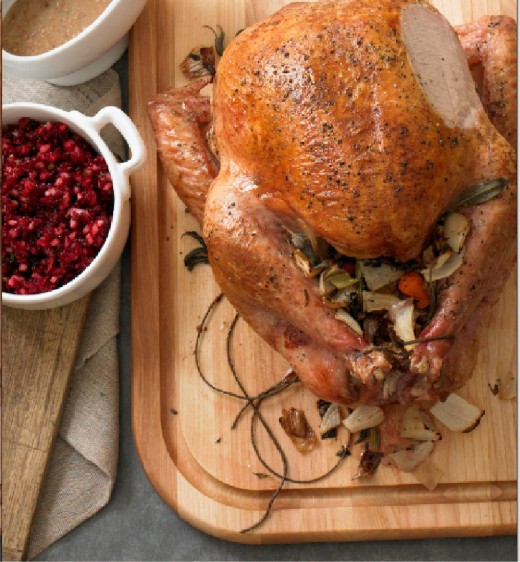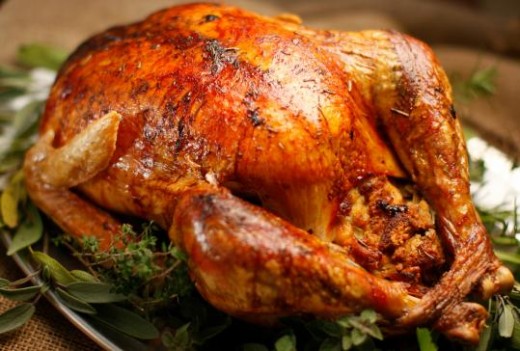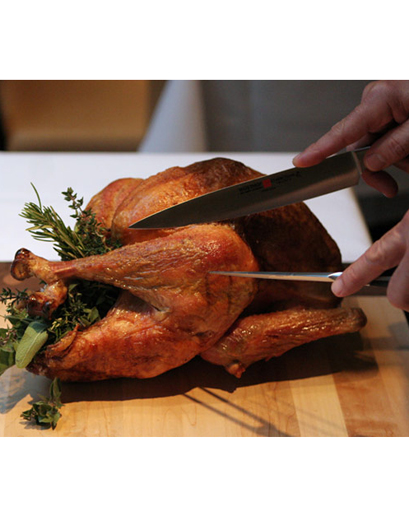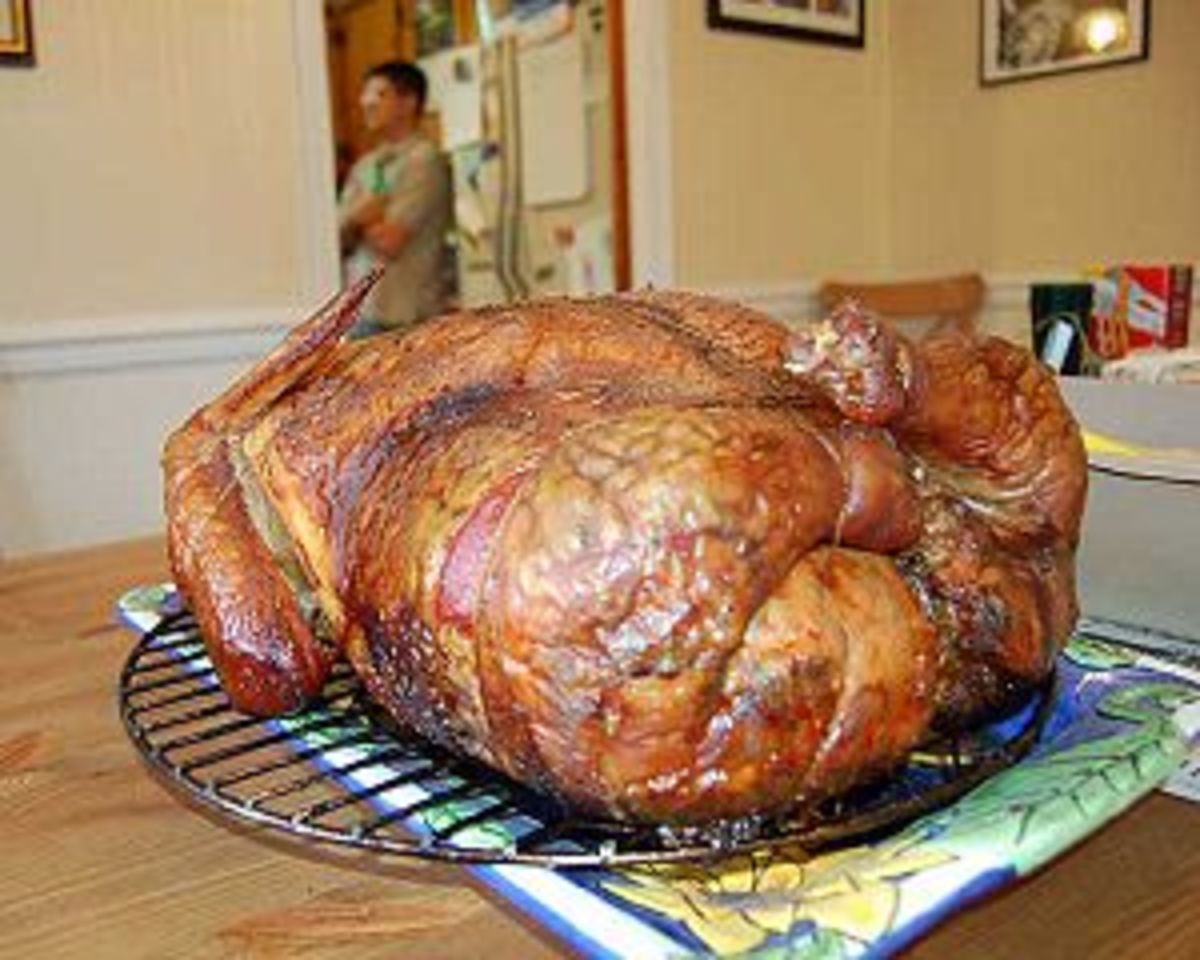Brining a Turkey - How to Brine a Turkey

Why brine?
Brining is a magic potion. I'm serious - it really is. There are a few tricks in the kitchen that rank in my top ten all time best tips - and brining is most definitely at the top of the list.
I've been brining all my life, although I didn't really realize it. My first brines were taught to me by my mother and grandmother, and used to produce truly perfect Southern Fried Chicken. As I got older, I experimented with other brines, and brined my first turkey when I was in my mid-teens. The results were so amazing, that to this day my mother calls me every single year the day before Thanksgiving to double check how to make my turkey brine.
Brining is a simple soak in a flavored salt water solution. That's it. There are tons of different ingredients that can be added to brine to impart a particular subtle flavor, and feel free to experiment with whatever your favorite sweet or savory ingredients are. But by allowing your turkey to sit for 12-24 hours in the brine, you'll ensure several things. First, the turkey will be fully flavored from the inside out - brining carries flavor into the meat itself. Secondly, the bird will be far juicier and more succulent than without the brine - the solution in which the bird soaks enters the meat and stays there during cooking, keeping it moist from start to finish. Finally, you'll have a much higher success with the bird no matter whether you choose to roast, deep fry, smoke or grill it. So when looking at your next turkey, make brining part of the equation. Don't skip it anymore than you'd skip cooking the bird. You'll be delighted.

How it works
Brining works through a combination of two basic principles - diffusion and osmosis. This just means that because cells like to be in an environment in which everything is the same on both sides of the cell walls, that they will allow salts and sugars (and other flavors) to enter the cells themselves, until they contain the same chemicals in the same amount as the solution does.
The solution is your brine. If you wish to carry seasoning, sugar, garlic, thyme or any host of other flavors into the very cells of the meat itself, then use a brine. The cells will come into contact with the solution and say to themselves 'wait - there's stuff out there we don't have"! They'll then happily allow all the goodness that you've put into the brine right inside the interior of the cells - where the yumminess stays while you cook it. And shows up when you eat it.
Sure that's a simplified explanation - this is about food, not osmosis or equilibrium of solution. But if you think about it this way, it makes much more sense, and you'll see why it's such an important step.

The Method!
You'll need minimal equipment, but the most important thing will be a vessel that will be large enough to hold your bird and keep it completely submerged while it's brining. There are XXL Ziploc baggies that will serve, or use a small cooler or large stockpot. No matter what you use, make sure that you have room in the fridge, or enough ice in your cooler, to keep the turkey very well chilled while it's brining. It must remain below 40F - that's the beginning of what the USDA calls the "Danger Zone". That's the temperature range between 40F and 140F when food borne causing bacteria can flourish. So make sure you have a way to keep your bird very cold.
You'll need:
-
1 cup kosher salt (If you must use table salt, use half the amount, but kosher is a much cleaner flavor)
-
1/2 cup light brown sugar
- 1 gallon vegetable broth
- 1 tablespoon black peppercorns
- 1 1/2 teaspoons all spice OR juniper berries
- 3 sprigs fresh rosemary, or 1 Tbl dried
- 4-5 sprigs fresh thyme, or 1 Tbl dried
- 3-4 dried bay leaves
- 4-5 cloves fresh garlic, peeled and smashed, but don't bother chopping
- 1 1/2 quarts of water
- enough additional water to completely submerge the bird in the container you've chosen.
- In a large sized saucepan or small stockpot, combine the broth, salt and sugar. Bring to a boil, stirring to dissolve the solids.
- Once the brine has begun to boil, add the remainder of the ingredients - peppercorns, all spice or juniper berries, rosemary, thyme, bay leaves and garlic.
- Allow brine to simmer for about five minutes, then remove from heat. Allow brine to chill completely before using. Never use a warm or hot brine with poultry - that's an invitation for food poisoning - not something you wish to serve up with your holiday.
- Once the brine has chilled, place your thawed bird in the container you've chosen, and add the chilled brine. Then add enough additional water and ice to absolutely cover the turkey. You may want to use a weighted plate to the top of the bird - they tend to want to float and you need to make sure the bird stays submerged.
- Allow the bird to brine for at least 12 hours. Overnight is ideal. The smaller the bird, the less time it will need - 12 hours is about perfect until you get into the 20 pound and larger range. Those can take up to 24 hours with no problem. Longer than that and you begin running the risk of the bird becoming salty, instead of seasoned.
- Once the turkey has sat in the brine for the right amount of time, simply remove it from the solution and rinse it off. Discard the brine - never ever reuse a poultry brine - the whole food borne illness thing again.
- Once rinsed, pat the bird as dry as possible inside and out, and place on a rack over a baking sheet. It's ready to go at this point - you can stuff and roast it at this point. However, if you want the absolutely crispiest skin, then stash the bird, uncovered, back in the fridge and allow it to air dry for at least 4-6 hours. This helps make sure the salts from the brine dry completely on the skin, leading to the most gorgeous bird you've ever seen. Let alone tasted.
That's it! That's all there is to a brined bird. It does take some pre-planning, but not much, and not one single step is difficult. For very little effort the pay off on a brine is magnificent, and once you try it the first time you'll never cook a turkey without it again. Once you've tried this particular brine recipe - my basic, delicious, go-to favorite - feel free to let your imagination go and add or subtract whatever strikes your fancy. Once word gets out what you can do with a turkey, you'll have every body's mama calling you before Thanksgiving too!
The website!
- The Thrillbilly Gourmet
Combining classic technique with everyday food for spectacular results!





